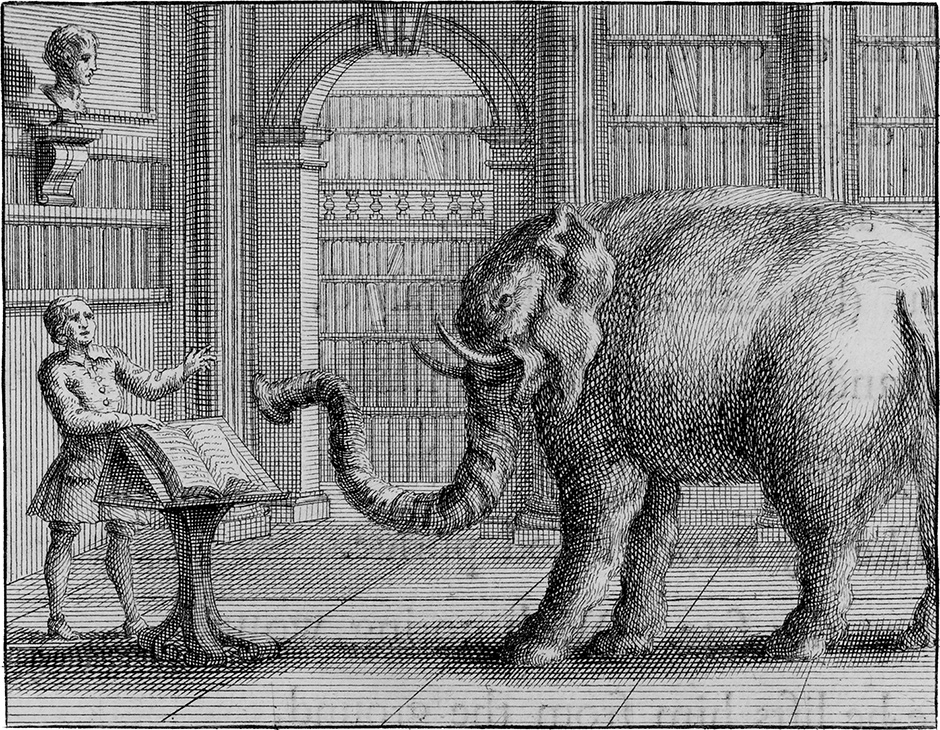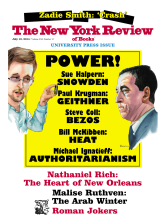In response to:
India: Censorship by the Batra Brigade from the May 8, 2014 issue

Bard Graduate Center, New York/Bruce White
‘The Elephant and the Bookseller’; eighteenth-century engraving from the exhibition ‘William Kent: Designing Georgian Britain,’ organized by the Bard Graduate Center and on view at the Victoria and Albert Museum, London, until July 13, 2014. The catalog is edited by Susan Weber and published by Yale University Press.
To the Editors:
In her essay “India: Censorship by the Batra Brigade” [NYR, May 8], Wendy Doniger touches on a number of issues when it comes to the academic study of religion and larger questions of representation. She frames the debate over her book, as well as other topics when it comes to Hinduism, as one between Hindu right-wing activists and scholars, which essentializes a complex history that involves academic freedom, religious sensitivity, and a history of, in Doniger’s words, talking past each other.
In referring to the revisions of the California textbooks several years ago, Doniger is wrong to claim that the textbook lawsuit was a “win” for scholars by mischaracterizing the debate as one of scholars versus Hindu activists. She cites extreme examples and proceeds to argue that Hindu-American activists across the country are trying to whitewash textbooks.
The actual history—which is a matter of public record—shows two separate lawsuits, and results that were partial victories for the plaintiffs. Indeed, many academics, including noted historians and past leaders of the American Academy of Religions, urged revisions to the textbooks based on inaccuracies about Hinduism. Hindu-Americans (and non-Hindus) who had nothing to do with the groups Doniger mentioned also chimed in. Most of these edits were in fact adopted, including the scrapping of the Aryan Invasion Theory due to a consensus among historians and archaeologists that it was outdated and inaccurate. It wasn’t about whitewashing Hinduism and Indian social history but, as Doniger herself notes, an opportunity to actually present Hinduism on par with any other religions covered in textbooks. For many Hindu-Americans, the inaccurate conflation between Hinduism and Indian social practices like caste or dowry in textbooks has led to years of bullying in schools across the country. Doniger acknowledges this in her essay, then proceeds to claim that those fighting for changes to textbooks are of the same mindset as Dinanath Batra, which is both ridiculous and offensive.
There are many advocates of religious pluralism of every faith who are trying to advance constructive understanding of diverse religions in the classroom. To single out Hindus is rather unfortunate given that education advocacy groups representing every major religion have been working on accuracy in textbooks for years. Perhaps this incident can lead to a constructive dialogue that leads to a more robust understanding of Hinduism and the legitimate concerns of many Hindu-Americans.
Murali Balaji, Ph.D.
Director of Education and Curriculum Reform
Hindu American Foundation
Washington, D.C.
Wendy Doniger replies:
I agree with what Mr. Balaji says here about Hindu-Americans, and indeed I expressed this view in my article, which he misreads in several instances. I did not “single out Hindus” for criticism; I was writing primarily about censorship in India, not about Hindus in America, and I did not “claim that those fighting for changes to textbooks are of the same mindset as Dinanath Batra,” but merely compared them on one point, the censoring of textbooks. I noted that caste, as well as “accuracy,” was an issue in both cases, but I was careful to distinguish the two instances: “The situation in the US is not the same as the situation in India, for many obvious reasons.”
I did not deny that “Hindu-Americans (and non-Hindus) who had nothing to do with the groups Doniger mentioned also chimed in”; I explicitly noted that “many Hindu-Americans testified against the proposed changes, siding with the scholars; the range of opinions among Hindus in the American diaspora is as diverse as it is among Hindus in India.” I said that “most of the proposed changes were not made”—most, not all. I did not “argue that Hindu-American activists across the country are trying to whitewash textbooks” but, rather, referred to “a small but growing group of Hindus in the American diaspora” who are lobbying for changes; I did not, and would not, call this “whitewashing.” I granted that “most textbooks, too, dwell upon, and exaggerate, the human abuses in the caste system and pay insufficient attention to the rest of Hinduism.” And I said more:
These concerns are entirely justified. Time and again, when I give a public lecture in the United States, no matter what I talk about, the first question from the American audience is: “What about the caste system?” Most textbooks, too, dwell upon, and exaggerate, the human abuses in the caste system and pay insufficient attention to the rest of Hinduism. But some of the Hindu interest groups have demanded that textbooks not mention the caste system at all, which can be as bad a distortion as the overemphasis on it.
If we are to achieve the “constructive dialogue” that both Mr. Balaji and I long for, it is important to read with an open mind, in order to celebrate the points on which we agree.



